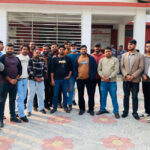Tome And Plume: Cosmic Mother Is Worshipped In MP For Over 2300 Years

**The Divine Legacy of Goddess Durga Worship in Madhya Pradesh**
*Bhopal (Madhya Pradesh):*
“It is the Divine Mother who exists in the form of the universe and pervades everything as Consciousness.” – Ramakrishna Paramhansa
The Shardiya Navratri festival is currently underway in Bhopal, with the city adorned in devotion to Goddess Durga. Hundreds of pandals across the city host beautifully installed idols of the goddess, resonating daily with hymns from the *Durga Saptashati* recited each morning and evening.
### Historical Roots of Durga Worship in Madhya Pradesh
The tradition of worshipping Goddess Durga’s idols in Madhya Pradesh dates back to the Mauryan era and even earlier. Excavations carried out between 1994 and 1996 in Ninore, Sehore district—about 56 km from Bhopal—unearthed two idols of Durga estimated to be around 2,300 years old. One notable idol discovered there has twelve arms and measures two inches tall, 12 cm long, 6 cm wide, and 1 cm thick.
These ancient idols have attracted the attention of many scholars of Indian iconography, including NP Joshi. Additionally, numerous sculptures of *Mahishasurmardini* were found in Hinglajgarh, Mandsaur district. These artifacts belong to the Gupta and Paramara periods, highlighting the long-standing cultural heritage of Durga worship in the region.
### Enduring Traditions: From Ancient Forts to Modern Festivities
The vibrant pandals and glowing lights that characterize Shardiya Navratri today have their origins thousands of years ago in Madhya Pradesh. The Sharda Temple in Maihar stands as a prominent example of this enduring tradition.
Turning to classical texts, the *Arthashastra* authored by Chanakya mentions Goddess Aparajita, a form of Durga. Chanakya advises worshipping Aparajita within forts for the protection of cities. Scholars suggest the goddess’s name, Durga, is etymologically linked to *Durg*, meaning fort, which ties into the discovery of her idols within the fort of Hinglajgarh. The name Aparajita translates to “undefeatable female power,” a fitting description of Goddess Durga.
### Connections with Mesopotamian Deities
Some scholars have drawn parallels between Goddess Durga and the Bactrian Goddess Nana. Nana, the patron deity of the Kushan empire, symbolized war, fertility, wisdom, and power. Originating possibly from Mesopotamia in the early second millennium BCE, Goddess Nana was worshipped by Emperor Kanishka-I in India. Her likeness appears on Kushan-era coins, and she was sometimes depicted with four arms holding weapons. These features bear some resemblance to depictions of Durga, prompting intriguing iconographic comparisons.
The Narmada Valley, known as a cradle of human civilisation, has yielded some of the oldest idols of Goddess Durga. Likewise, Mandsaur was an ancient site for the worship of her statues.
### Durga and Inanna: Shared Symbolism, Different Essence
Further historical inquiry suggests links between Durga and the Mesopotamian goddess Inanna. Both deities are often depicted seated on a lion or tiger—symbols of power. Historians note that Inanna’s eight stars may symbolize the ten hands of *Mahishasurmardini* (Durga).
The ancient Mesopotamians engaged in trade and cultural exchange with the Indus Valley civilization, possibly explaining the iconographic similarities between Durga and Inanna. However, there is a fundamental difference: Inanna represents fertility and material power, whereas Durga epitomizes divine power, wisdom, blessings, and justice.
Durga’s worship is believed to liberate the soul from the cycle of birth and death (moksha). She is revered as *Moksha Datri* (liberator of the human soul), who grants freedom even to the demon king Mahishasura after destroying him. Hence, Mahishasura is also respected and offered food alongside the goddess during rituals.
### The Power of Mahamaya
Goddess Durga is also known as *Mahamaya* because even uttering her name sincerely dispels illusions and clears the mind. This divine power forms the foundation of the enduring reverence and celebration during Navratri, a festival that brilliantly continues a spiritual legacy thousands of years in the making.
—
Celebrate the divine feminine power and join the vibrant festivities honoring Goddess Durga this Navratri in Madhya Pradesh—a tradition rooted deeply in history, culture, and cosmic consciousness.
https://www.freepressjournal.in/bhopal/tome-and-plume-cosmic-mother-is-worshipped-in-mp-for-over-2300-years









